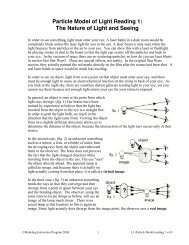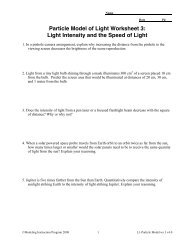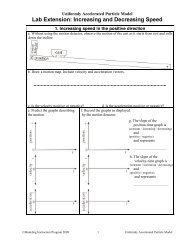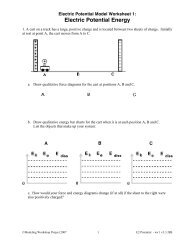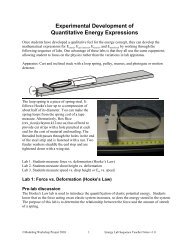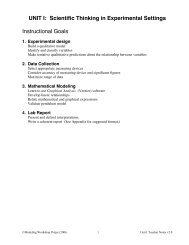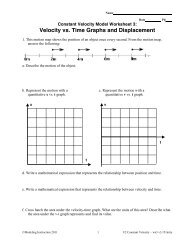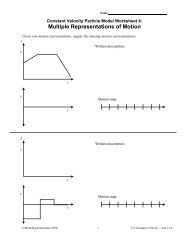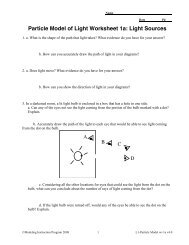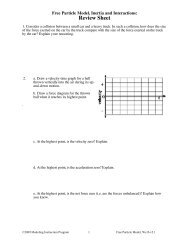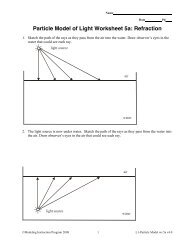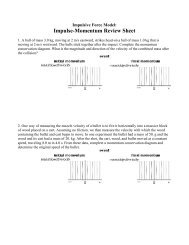A handout to accompany my presentation. - Modeling Physics
A handout to accompany my presentation. - Modeling Physics
A handout to accompany my presentation. - Modeling Physics
Create successful ePaper yourself
Turn your PDF publications into a flip-book with our unique Google optimized e-Paper software.
A Model-Based Approach <strong>to</strong> Energy Instruction<br />
The materials that follow are adapted from materials developed for the <strong>Modeling</strong> Instruction<br />
Project. They have been inspired and guided by Dr. David Hestenes' “<strong>Modeling</strong> Methodology for<br />
<strong>Physics</strong> Teachers.”<br />
For more information about the modeling instruction project or <strong>to</strong> download additional<br />
curriculum materials, go <strong>to</strong> http://modeling.asu.edu or contact Mark Schober,<br />
mschober@jburroughs.org<br />
Introduction:<br />
These materials present some ideas about work and energy that are different from the traditional<br />
approach. These new ideas are generally much clearer and simpler than the traditional thinking,<br />
but it does mean you might have <strong>to</strong> adapt or let go of some of your ways of thinking about<br />
energy and work. Your use of language is very important in this shift. For example, the<br />
difference between energy transformations or forms of energy (old) and energy transfer (new) is<br />
subtle but crucial, since energy transformations implies that there are different forms of energy - a<br />
misleading idea which can be partially avoided by the use of the term energy transfer, which<br />
stresses the universal nature of energy. (This will be elaborated on in the Teacher Notes.) It may<br />
be a matter of changing some deeply ingrained thinking and terminology, but give it a try, you'll<br />
like it!<br />
Contents:<br />
Part 1: Summary of the Main Themes and Concepts for the Energy Model<br />
Part 2: Energy Transfer and S<strong>to</strong>rage vs. Energy Forms<br />
Part 3: Justification and Goals for the Model-Based Approach <strong>to</strong> Energy; Energy<br />
Misconceptions<br />
Part 4: Re<strong>presentation</strong>al Tools: Examples and Instructions for Use<br />
Part 5: Sample Instructional Sequence<br />
Part 6: Student Objectives<br />
©<strong>Modeling</strong> Workshop Project 2003 1 Energy Teacher Notes v2.0
Part 1: Summary of the Main Themes and Concepts<br />
for the Energy Model<br />
I. The Model:<br />
• Energy is presented as a means of interaction between objects with internal structure. (Contrast<br />
this with the view of force interactions that occur between objects or point particles without<br />
internal structure.)<br />
• The 1st Law of Thermodynamics/ Conservation of Energy are used as the underlying models of<br />
energy interaction.<br />
II. Two Energy Themes: Energy transfer and energy s<strong>to</strong>rage<br />
• focusing on modes of energy transfer and s<strong>to</strong>rage, not forms of energy<br />
A. Energy Transfer: Energy is transferred across a system boundary by three modes:<br />
Heating (Q) - due <strong>to</strong> difference in temperature<br />
Radiation (R) - by pho<strong>to</strong>ns/EM waves<br />
Working (W) - by external forces<br />
These are considered macroscopic processes. These modes are NOT properties of the system.<br />
They do not represent changes in the state of the system, hence we do not use the ∆ notation <strong>to</strong><br />
describe them. Since they are processes, and not intrinsic in the system, we feel it is better <strong>to</strong> use<br />
the gerunds; otherwise students may come <strong>to</strong> view Q, R and W as parts of the system ( e.g., a<br />
system does not possess "heat").<br />
B. Energy S<strong>to</strong>rage: Energy is s<strong>to</strong>red in a system as internal energy. This internal energy is a<br />
property or state variable of the system, due <strong>to</strong> the microscopic energies of the particles of the<br />
system. These particle energies cannot be measured directly. A change in internal energy is all<br />
that can be accounted for, since a change in internal energy results in a change in the state<br />
variables of the system (pressure, temperature, etc), so the internal energy is represented with ∆<br />
notation.<br />
There are a variety of mechanisms of energy s<strong>to</strong>rage which can be accounted for as types of<br />
internal energy: potential energies (particle interaction energies-gravitational and elastic), kinetic<br />
energy (particle motion relative <strong>to</strong> the center of mass of the system), chemical energy (particle<br />
bond energies), and thermal internal energies (random particulate motion as a result of frictional<br />
effects), designated as ∆E g, ∆E el, ∆E k, ∆E chem, and ∆E diss respectively.<br />
Together these make up ∆E, the change in internal energy.<br />
∆E = ∆E g + ∆E el + ∆E k + ∆E chem +∆E diss .<br />
III. A Qualitative Definition of Energy:<br />
Energy is a measure of a conserved, substance-like quantity that has the capability <strong>to</strong> produce<br />
change. By identifying the nature or source of the change (ie, change in motion, position, shape,<br />
temperature, etc.) one can identify the means of energy transfer or s<strong>to</strong>rage.<br />
(Forces can produce change but are neither conserved nor substance-like. Momentum is both<br />
conserved and substance-like, but it can only describe changes in motion. Mass is a conserved<br />
and substance-like property of matter that has the capability <strong>to</strong> produce change in chemical and<br />
nuclear reactions. Mass is very closely related <strong>to</strong> energy, differing only in its additional<br />
properties of inertia and gravitational interaction.)<br />
©<strong>Modeling</strong> Workshop Project 2003 2 Energy Teacher Notes v2.0
IV. The 1st Law of Thermodynamics, and Conservation of Energy<br />
According <strong>to</strong> the Law of Conservation of Energy, the algebraic sum of changes in internal energy<br />
in the system must equal the energy transfers across the system boundary.<br />
In this unit, we designate all processes that increase the energy of the system as positive:<br />
transferring energy in<strong>to</strong> the system by heating it, working on the system (energy transferred in<br />
by forces), etc.<br />
Energy that decreases the energy of the system is designated as negative; such as energy<br />
leaving by cooling a system, or working done by a system (energy transferred out by forces).<br />
So the 1st Law of Thermodynamics can be stated as:<br />
∆E = Q + W + R<br />
where ∆E is the sum of all the changes in internal energies, using the same sign designation as<br />
stated above.<br />
To use the 1st Law in this form, one must identify the system first, and then determine the<br />
appropriate forms of internal energy s<strong>to</strong>rage mechanisms which undergo changes, and which<br />
modes of energy transfer are involved.<br />
V. System Identification:<br />
The identification of the system and its boundaries is arbitrary but critical for accurate energy<br />
interaction analysis. The larger the system designation, the more energy interactions will be<br />
classified as internal energies rather than external energy transfers.<br />
VI. Re<strong>presentation</strong>al Tools:<br />
This unit utilizes three re<strong>presentation</strong>al <strong>to</strong>ols, which are listed here according <strong>to</strong> their increasing<br />
levels of complexity. Their use will be explained in detail in a later section:<br />
1. Energy Pie Charts:<br />
• very qualitative, and relatively limited use - generally for introduc<strong>to</strong>ry use, especially <strong>Modeling</strong><br />
units, as post-lab discussion<br />
• introduces the idea of internal energy as a property of a system<br />
• introduces the concept of changes in internal energy of the system<br />
• stresses the importance of system identification<br />
• introduces the various mechanisms of energy s<strong>to</strong>rage, including ∆E therm for frictionally dissipated<br />
energy<br />
• does not represent energy transfers across system boundary, except for some simple examples of<br />
external forces<br />
• represents Conservation of Energy and 1st Law of Thermodynamics<br />
• introduces internal energy as a sum of energies:<br />
∆E = ∆E g + ∆E el + ∆E k + ∆E chem +∆E diss<br />
©<strong>Modeling</strong> Workshop Project 2003 3 Energy Teacher Notes v2.0
2. Energy Bar Graphs and Flow Diagrams (essentially energy system schema)<br />
• <strong>to</strong> be used in <strong>Modeling</strong> unit addenda, in post-lab discussions<br />
• identifies internal energy changes, but also shows means of energy transfer across system<br />
boundary<br />
• introduces concept of work as energy transfer across system boundary via external forces<br />
• makes distinction between changes in internal energy and energy transfer as a process.<br />
• shows how macroscopic energy transfer W, Q, R can affect microscopic energy s<strong>to</strong>rage ∆E<br />
(internal energy)<br />
• introduces 1st law of Thermodynamics: ∆E = W<br />
• slightly more quantitative than pie charts<br />
• represents Conservation of Energy and 1st Law of Thermodynamics<br />
3. The Equation of Everything: W + Q + R = ∆E k + ∆E i + ∆E p = ∆E<br />
• comprehensive treatment of 1st Law of Thermodynamics<br />
• quantitative treatment of Energy Bar Graph / Flow Diagrams<br />
VII. Quantitative Development of Work and Energy<br />
1. The spring labs<br />
• paradigm labs develop quantitative definitions E el = 1/2k∆x 2 , E k = 1/2 mv 2 ,<br />
E g = mgh, W = F•∆x.<br />
But we will officially define "working" as simply another mode of energy transfer, via external<br />
forces.<br />
• presents the work-energy theorem(center-of-mass calculations) as a relationship for particles<br />
with no internal structure:<br />
F net •∆x = 1/2mv 2<br />
2. Energy analysis misconceptions<br />
• limitations of center-of-mass approach (work-energy, point particle) are shown with the<br />
<strong>presentation</strong> of the paradoxical, contradic<strong>to</strong>ry energy situations which require 1st Law of<br />
Thermodynamics analysis of a system with internal structure in order <strong>to</strong> account for internal<br />
energy changes and be conceptually accurate:<br />
1. Frictional dissipation (sliding a block on a frictional surface)<br />
2. Deformable objects (inelastic collision, a jumping person)<br />
VIII. Classical Thermodynamics as an Extension of Mechanics<br />
3. Equation of Everything<br />
The more formal treatment of thermodynamics begins, under the umbrella of the Equation of<br />
Everything:<br />
W + Q + R = ∆E k + ∆E i + ∆E p<br />
The Equation of Everything is a comprehensive statement (a working model) of the First Law of<br />
Thermodynamics that accounts for macroscopic energy transfer as heating, work, and radiation,<br />
and microscopic internal energy changes, as kinetic, interaction(potential), or particle(chemical)<br />
energy.<br />
©<strong>Modeling</strong> Workshop Project 2003 4 Energy Teacher Notes v2.0
Part 2 - Energy Transfer and S<strong>to</strong>rage<br />
vs. Energy Forms<br />
Typically, energy is described as having different forms or types. Many different forms are<br />
presented: light energy, kinetic energy, electrical energy, and so on. Energy is described as<br />
coming in these different forms, and as being able <strong>to</strong> change forms via various transformation<br />
processes or mechanisms.<br />
In this unit, we are proposing a shift from this emphasis on different forms of energy <strong>to</strong> a<br />
focus on what happens <strong>to</strong> energy, while treating energy as a single, conserved, fundamental<br />
quantity. Instead of exploring energy forms or transformations, the interest lies in the questions<br />
of energy transfer and s<strong>to</strong>rage.<br />
The Problem with Energy “Forms”<br />
Treating energy as having different forms (ie, heat energy vs. sound energy vs. light energy,<br />
etc.) implies that these quantities are fundamentally different in some way. One runs the risk of<br />
introducing an artificial level of complexity because questions naturally arise: what is different<br />
about the forms Is it a difference in how the energy is s<strong>to</strong>red or exchanged or how it flows or<br />
all of the above How does one distinguish among the different forms of energy<br />
It is much simpler instead <strong>to</strong> focus on two questions: how energy flows and how it is s<strong>to</strong>red.<br />
Underlying this shift in focus is the critical understanding that all energy is the same conserved,<br />
substance-like “stuff ”; that there are not different forms or types of energy. Energy can be<br />
defined as the capability <strong>to</strong> produce change. The changes produced might be different - changes<br />
in position, changes in shape, etc, but the energy that produced those changes is fundamentally<br />
the same.<br />
Energy As a Flowing, Substance-Like Quantity<br />
A quantity can be called “substance-like” if a density can be assigned <strong>to</strong> it, and if it can flow<br />
through space. Some substance-like quantities include mass, electric charge, and amount of<br />
matter. It is generally agreed that a substance-like quantity is conserved, whereas the principle<br />
of conservation does not apply <strong>to</strong> a non-substance-like quantity such as temperature or velocity<br />
or electric field. Therefore, according <strong>to</strong> these qualifications, energy can be described as a<br />
conserved, substance-like quantity, because a density can be attributed <strong>to</strong> it, it flows through<br />
space, and it is conserved.<br />
As a substance-like quantity, energy can be transported, exchanged, and s<strong>to</strong>red. Energy<br />
flows, and can be s<strong>to</strong>red, and can be transferred. But it is all the same "stuff." A helpful analogy<br />
is presented in <strong>Physics</strong> - A Contemporary Perspective by Randy Knight. 1 in which energy is<br />
compared <strong>to</strong> money. Money can be s<strong>to</strong>red in a variety of places - it can be in a money market<br />
account, or a checking account, in a wallet, or under the mattress. And money can be transferred<br />
by a variety of means - credit card, personal check, cash, an IOU, a savings bond. But<br />
ultimately, fundamentally, it is all the same thing: money. The means of transferring or s<strong>to</strong>ring<br />
the money varies; the fundamental nature of money does not. The same reasoning can be applied<br />
<strong>to</strong> energy: it can be s<strong>to</strong>red by various mechanisms (internal energies, potential energies) and can<br />
be transferred by a number of modes (working, heating, radiation) but it is still all the same<br />
substance.<br />
1<br />
Knight, R. <strong>Physics</strong> - A Contemporary Perspective, Addison-Wesley, 1996<br />
©<strong>Modeling</strong> Workshop Project 2003 5 Energy Teacher Notes v2.0
Consider also that we do not discuss different forms of other substance-like quantities. We<br />
do not distinguish between types of electric charge or types of momentum. We don’t speak in<br />
terms of “electron charge” or “positronic charge” or “ionic charge.” “ If the substance-like nature<br />
of energy is <strong>to</strong> be taken just as seriously as the substance-like nature of electric charge, then<br />
speaking about different forms of energy is just as misleading as speaking about different forms<br />
of charge would be.” 2<br />
The main idea is <strong>to</strong> talk in terms of energy transfer modes instead of energy forms. For<br />
example, instead of saying “heat energy flows from the table <strong>to</strong> the ice cube”, one would say<br />
“energy is transferred from the table <strong>to</strong> the ice cube by heating, due <strong>to</strong> a temperature difference.”<br />
Instead of saying “the gravitational potential energy of the ball is converted <strong>to</strong> kinetic energy,”,<br />
one would say “the ball originally has energy s<strong>to</strong>red due <strong>to</strong> gravity, which is then transferred <strong>to</strong><br />
the energy of motion.” Instead of saying “work is done on the spring” one would say “energy is<br />
transferred <strong>to</strong> the spring by way of an external force , where it is s<strong>to</strong>red by the spring.”<br />
The key distinction in these examples is that the source of the energy and the mode of<br />
transfer of the energy are stressed, and these sources or modes may change, but it’s still just<br />
energy that is flowing.<br />
Why bother Pedagogical Justification<br />
A shift of emphasis from energy forms <strong>to</strong> energy transfer and s<strong>to</strong>rage is advantageous because:<br />
1. It provides a more accurate re<strong>presentation</strong> of the universal nature of energy. It avoids the<br />
misleading idea that there are different kinds of energies, and the ambiguities inherent in this<br />
outlook.<br />
2. One can focus instead on the changes that are occurring in terms of energy transfer and s<strong>to</strong>rage<br />
instead of trying <strong>to</strong> identify the type of energy. Focus attention on energy interactions via these<br />
three questions:<br />
Where does the energy come from<br />
Where does the energy go<br />
What does the energy do<br />
2 “Energy Carriers or Energy Forms” Falk, Herrmann, and Schmid. American Journal of <strong>Physics</strong>. 51 (12)<br />
December 1983.<br />
©<strong>Modeling</strong> Workshop Project 2003 6 Energy Teacher Notes v2.0
Part 3 - Justification and Goals for the Model-Based<br />
Approach <strong>to</strong> Energy; Energy Misconceptions<br />
The shift from energy forms <strong>to</strong> an emphasis on energy transfer and s<strong>to</strong>rage may seem like merely<br />
a semantic change. The natural question is what is the point of this shift How will it change<br />
anything we teach in mechanics or energy or thermodynamics, ultimately The answer is that the<br />
goal behind such a change in focus is <strong>to</strong> facilitate a more accurate method of analysis of<br />
mechanical systems. This approach will rely more on the 1st Law of Thermodynamics and<br />
Conservation of Energy and less on the work-energy relationship that is usually so prevalent, but<br />
which has substantial conceptual shortcomings in a number of physical situations. These will be<br />
elaborated on later in the examples that follow.<br />
The study of work and energy in mechanical systems typically utilizes the "work-energy<br />
theorem", stating that the work done on an object, F net •∆x, is equal <strong>to</strong> the change in kinetic energy<br />
of the object, 1/2m∆v 2 .<br />
F net •∆x = 1/2m∆v 2<br />
While this equation yields the correct numerical answer in simple situations, it can be very<br />
misleading. "Serious difficulties begin <strong>to</strong> enter, however, when [it is] uncautiously extended <strong>to</strong><br />
systems of interacting particles or <strong>to</strong> objects that are treated as continuous but are deformable or<br />
have other internal degrees of freedom." 1 The work-energy equation is conceptually valid only<br />
when the system under consideration is taken <strong>to</strong> be a point particle with no internal structure,<br />
and all measurements are relative <strong>to</strong> the center of mass of the system. Therefore, any situations<br />
involving frictional forces or deformation of the system lead <strong>to</strong> energy paradoxes, since they<br />
involve internal structure issues which are not included in this work-energy, dynamical, point<br />
particle analysis.<br />
In order <strong>to</strong> address/prevent/avoid these misconceptions, the 1st Law of Thermodynamics (∆E =<br />
Q+W) can readily be applied, either alone or in conjunction with the work-energy (center of<br />
mass) equation (F•∆x = 1/2m∆v 2 ). By using the 1st Law and Conservation of Energy, the<br />
internal structure of the system can be taken in<strong>to</strong> account, and a more valid model of the system<br />
can be used in the energy analysis.<br />
The goal of this unit is <strong>to</strong> build a complete model of energy interactions under the umbrella of the<br />
Equation of Everything (a restatement of the 1st Law of Thermodynamics) using re<strong>presentation</strong>al<br />
<strong>to</strong>ols and paradigm labs <strong>to</strong> develop this model. The model will then be used <strong>to</strong> analyze<br />
mechanical systems accurately, taking in<strong>to</strong> account the internal structure of the system. This will<br />
prevent the misconceptions that tend <strong>to</strong> develop when using exclusively dynamical interactions<br />
for analysis and ignoring internal structure and internal energy issues.<br />
1<br />
A. Arons, Teaching Introduc<strong>to</strong>ry <strong>Physics</strong>, John Wiley & Sons, 1997<br />
©<strong>Modeling</strong> Workshop Project 2003 7 Energy Teacher Notes v2.0
Three Situations Involving Misconceptions Regarding Work(ing)<br />
The three situations below are examples of the inaccurate use of the work-energy theorem for<br />
analyzing a mechanical system. They show how using the 1st Law of Thermodynamics can<br />
clarify the energy interactions involved.<br />
Dynamical Analysis: based on work-energy theorem and center of mass calculations, considering<br />
object as point particle<br />
F net •∆x cm = 1/2m ∆v cm<br />
2<br />
Energy Analysis: based on 1st Law of Thermodynamics and Conservation of Energy<br />
∆E = Q +W<br />
where Q = energy transferred by heating (due <strong>to</strong> temperature difference), and<br />
W = energy transferred by working (via external forces)<br />
*******************************************<br />
Misconception 1. Sliding a block along a frictional<br />
p<br />
surface at constant velocity<br />
cm<br />
Ff<br />
Dynamical Analysis:<br />
∆x<br />
• F net = 0 due <strong>to</strong> constant velocity (∆v=0)<br />
• F p = F k and 1/2m∆v 2 = 0<br />
Therefore:<br />
(F p - F k ) ∆x cm = 0, so W net = 0<br />
• Therefore, seemingly no work is done on the block. HOWEVER, the block heats up! Where<br />
does this new energy come from, if no work is done and no energy is added by heating This is<br />
where the dynamical analysis breaks down, by not accounting for internal structure, and where a<br />
1st Law energy analysis is needed.<br />
Energy Analysis:<br />
• What is the system<br />
-->block AND surface - this allows treatment of friction as an internal energy issue instead of an<br />
external force transferring energy<br />
• ∆E = internal energies of system.<br />
• What are the internal energies that change<br />
-->internal thermal energy, E therm (E diss ), due <strong>to</strong> friction (*see E dissipated commentary below)<br />
--> notice that E k does not change, so it is not included in ∆E accounting<br />
• What is Q<br />
--> 0, no external source of heating is present<br />
• What is W<br />
--> W = F p •∆x due <strong>to</strong> external force imparting the push, adding energy<br />
Therefore, the work done by the push is dissipated <strong>to</strong> internal thermal energy of the system: W<br />
= F p •∆x = ∆E diss<br />
From there, what happens <strong>to</strong> that energy<br />
• ∆E diss = Q because block increases in temperature, so energy is lost <strong>to</strong> surroundings through<br />
heating (due <strong>to</strong> temperature difference).<br />
©<strong>Modeling</strong> Workshop Project 2003 8 Energy Teacher Notes v2.0
*Commentary: “Dissipated Energy”<br />
In analyzing the situation of pulling a block along a surface at constant velocity, Arons 3<br />
designates the block and the surface <strong>to</strong>gether as the system. In this case, he says the work done<br />
by the pulling force is “dissipated.” This “dissipated energy” is s<strong>to</strong>red as “thermal internal<br />
energy,” which he then calls E therm . E therm is one way of internal energy s<strong>to</strong>rage (others include<br />
chemical potential energy, elastic potential energy, etc.) and is the energy of the random<br />
molecular motion of the system. It is thermal internal energy due <strong>to</strong> internal (microscopic)<br />
interactions, which we perceive as a change in the temperature of the system. It is important <strong>to</strong><br />
recognize that the change in temperature of the system is NOT due <strong>to</strong> the addition of energy by<br />
external heating, but is instead a result of the change in internal energy of the system.<br />
To avoid the confusion and connotation with heat that the word thermal would probably<br />
cause (since at the initial, introduc<strong>to</strong>ry level the issue of heating will not be addressed), we are<br />
using the term E diss in the same sense that Arons uses E therm . It seems likely that using the<br />
word “thermal” prematurely could lead <strong>to</strong> misconceptions about heat and temperature.<br />
We will designate E diss as the energy dissipated due <strong>to</strong> frictional forces. This is equivalent <strong>to</strong><br />
Arons’ E therm . However, E diss in this unit will also include other dissipative mechanisms such<br />
as sound and light. (Arons uses a separate term, E misc <strong>to</strong> designate these other mechanisms.)<br />
With proper use of the pie charts, it will be obvious that this dissipated energy is not lost,<br />
(ie, gone) but is still within the system. The difference is that the energy is no longer “usable” or<br />
easily measurable, or recoverable. This is a subtle distinction, and one that students may have <strong>to</strong><br />
wrestle with and get a feel for. The reversibility or irreversibility of a process may be somewhat<br />
helpful in elucidating this idea of dissipation.<br />
To tie E diss in with the money analogy, dissipated energy is analogous <strong>to</strong> the service charges<br />
that the bank incurs for transactions - it is money that is still within the system, but is lost from<br />
our account, never <strong>to</strong> be recovered!<br />
Misconception 2.<br />
Vertical Jumping<br />
Dynamical Analysis:<br />
f=0 m<br />
• ∆v = 0 - v i<br />
m<br />
∆hcm<br />
• F net = F N - mg<br />
N<br />
i<br />
Therefore:<br />
(F N - mg)•∆h = 1/2 mv i<br />
2<br />
g<br />
F N •∆h - mg∆h = 1/2 mv i<br />
2<br />
F N •∆h = mg∆h + 1/2 mv i<br />
2<br />
• BUT, the normal force F N does no work because there is no displacement where the force is<br />
applied. The quantity F N •∆h is "pseudowork".<br />
• So where does the energy come from <strong>to</strong> propel the person upward, adding kinetic and<br />
gravitational potential energy<br />
Energy Analysis<br />
3 Arons, A.B. A Guide <strong>to</strong> Introduc<strong>to</strong>ry <strong>Physics</strong> Teaching , Wiley and Sons, 1990.<br />
©<strong>Modeling</strong> Workshop Project 2003 9 Energy Teacher Notes v2.0
• What is the system<br />
-->person + earth so that gravitational energy can be treated as internal energy<br />
• What internal energies that change are involved<br />
--> ∆E = ∆E grav pot + ∆E kin - ∆E chem(body)<br />
• What work is involved<br />
-->none - no external forces are involved <strong>to</strong> transfer energy<br />
• So, ∆E grav pot + ∆E kin - ∆E chem(body) = 0<br />
mg∆h + 1/2 mv 2 i - ∆E chem(body) = 0<br />
∆E chem(body) = mg∆h + 1/2 mv i 2<br />
• The energy producing the change in motion and height come from chemical energy of the body,<br />
NOT from work done by the normal force. The normal force does "pseudowork" - related <strong>to</strong> the<br />
displacement of the center of mass, yet not true work in the formal definition of displacement<br />
due <strong>to</strong> an applied force.<br />
• The misconception arises from the deformation of the object, which can only be accounted for by<br />
acknowledging the object's internal structure.<br />
• If one considers the system <strong>to</strong> be only the jumper, then the COE equation yields:<br />
F N ∆h = ∆E chem<br />
Misconception 3. Collisions - Elastic and Inelastic (ball colliding with a wall)<br />
Dynamical Analysis: W net = ∆Ek<br />
F N •∆x cm = 1/2 m∆v 2 ( ∆v= 0-v o )<br />
• However, F N does no work, because the displacement is not occurring at the<br />
object boundary, where the force is applied. Thus, FN is a zero-work force.<br />
Energy Analysis:<br />
•system = ball + wall<br />
• ∆E = W + Q<br />
•∆E = - ∆Ek + ∆Eel + ∆Ediss = 0 (no working or heating, W & Q = 0)<br />
• ∆Ek = ∆Eel + ∆Ediss<br />
• 1/2m∆v 2 = ∆Eel + ∆Ediss<br />
• FN• ∆x is numerically equivalent <strong>to</strong> 1/2m∆v 2 , but FN •∆x is not doing real work, due <strong>to</strong> the<br />
deformation, and consequent change in internal energies.<br />
Therefore:<br />
• If Eel = 0 , (ie, clay ball = perfectly inelastic) all the Ek is dissipated <strong>to</strong> Ediss.<br />
∆Ek = ∆Ediss<br />
• If Ediss = 0 (ie, superball = perfectly elastic collision) all the Ek is s<strong>to</strong>red as Eel<br />
∆Ek = ∆Eel<br />
©<strong>Modeling</strong> Workshop Project 2003 10 Energy Teacher Notes v2.0
Part 4 - Re<strong>presentation</strong>al Tools:<br />
Examples and Instructions for Use<br />
1. These re<strong>presentation</strong>al <strong>to</strong>ols are designed <strong>to</strong> show energy status for a defined system in terms of<br />
transfer and/or s<strong>to</strong>rage at various stages in a process. These stages are generally before and after<br />
the event occurs, but it is often helpful <strong>to</strong> address intermediate stages as well.<br />
2. The key <strong>to</strong> successful use of these <strong>to</strong>ols is appropriate designation of the system <strong>to</strong> be analyzed -<br />
what components are <strong>to</strong> be included in the system, and what is <strong>to</strong> be relegated <strong>to</strong> the<br />
surroundings.<br />
In general, the more components one includes in the system, the more one will focus on<br />
internal energies and energy s<strong>to</strong>rage. This simplifies situations involving friction. The fewer<br />
components included in the system, the more one will have <strong>to</strong> account for energy transfer across<br />
the system boundary. As a result, the larger the system, the simpler the analysis (generally).<br />
By controlling the choice of the system <strong>to</strong> be analyzed, the teacher can guide the discussion<br />
<strong>to</strong> focus on the energy interactions that are most relevant at that time in that particular lesson.<br />
Guiding questions may help in with energy analysis:<br />
1. What is the system<br />
2. Where is the energy coming from (Where is it s<strong>to</strong>red)<br />
3. Where does the energy go, and/or what does it do (How does it transfer or flow)<br />
Re<strong>presentation</strong>al Tool #1: ENERGY PIE CHARTS<br />
Goals and Notations of Usage:<br />
1. Goal: <strong>to</strong> qualitatively represent changes in internal energies/energy s<strong>to</strong>rage (including energy<br />
“dissipated” due <strong>to</strong> the effects of friction-see Commentary on Dissipated Energy on page 9) as a<br />
system undergoes some process. Pie charts are NOT designed <strong>to</strong> address energy transfers across<br />
the system boundary, but they can be adapted <strong>to</strong> include this, and this will be done in some of<br />
the later unit addenda.<br />
2. Goal: <strong>to</strong> qualitatively represent the Conservation of Energy and the First Law of<br />
Thermodynamics<br />
3. The energy notation in the pie charts should be E__, with subscripts indicating the source of the<br />
internal energy. These will generally be E k (kinetic energy, defined as the energy of motion) , E g<br />
( gravitational potential energy, a type of interaction energy), E el (elastic potential energy-again,<br />
interaction energy), and E diss (energy dissipated <strong>to</strong> internal thermal energy due <strong>to</strong> friction, or<br />
other mechanisms such as sound and light)<br />
This E__ notation, as opposed <strong>to</strong> KE, or GPE, or EPE is used for two reasons:<br />
1. It stresses the universal nature of energy - it is all energy.<br />
©<strong>Modeling</strong> Workshop Project 2003 11 Energy Teacher Notes v2.0
2. In this energy unit, we will use E__ <strong>to</strong> indicate the mechanisms of energy s<strong>to</strong>rage involved in<br />
these various types of internal energy.<br />
Symbols of energy transfer ( across the system boundary) will be Q (heating as energy transfer<br />
due <strong>to</strong> temperature difference, R (radiating), and W (working as energy transfer by an external<br />
force). These terms (Q, W, and R) will not be used with the pie charts, since the pie charts focus<br />
on energy s<strong>to</strong>rage and internal energy changes.<br />
Examples of Pie Chart Usage<br />
Example 1: a spring-launched <strong>to</strong>y which is propelled in<strong>to</strong> the air<br />
system: spring and <strong>to</strong>y object<br />
v=0<br />
system boundary<br />
alf way down<br />
Corresponding Pie Charts:<br />
1. . 3.<br />
Eel<br />
g<br />
nergy is now s<strong>to</strong>red<br />
ue <strong>to</strong> gravity<br />
gravitational potential<br />
nergy)<br />
g<br />
k<br />
nergy is now split<br />
etween energy of<br />
otion and energy due<br />
o gravity.<br />
Analysis<br />
1. It is critical <strong>to</strong> identify the system first. In this case, if the spring were NOT included in the<br />
system, the <strong>to</strong>y would initially have no energy, and the spring would then transfer energy <strong>to</strong> the<br />
<strong>to</strong>y by an external force across the system boundary (work). This is more complex, and is<br />
difficult <strong>to</strong> represent using the pie charts, which were designed only <strong>to</strong> address internal energy<br />
changes, not energy transfers across the system boundary.<br />
Try <strong>to</strong> identify the system so the energies are internal when using the pie charts. The goal is<br />
<strong>to</strong> focus on energy s<strong>to</strong>rage. The key is <strong>to</strong> make the system as inclusive as possible. It is<br />
recommended that the earth always be included in the system, so that E g can always be<br />
considered an internal energy, rather than thinking in terms of the "work done by gravity."<br />
2. Notice that the sizes of the circles are all the same. This is the implicit re<strong>presentation</strong> of the<br />
Conservation of Energy. If the <strong>to</strong>y were launched by a stronger spring, the circles would be<br />
larger.<br />
©<strong>Modeling</strong> Workshop Project 2003 12 Energy Teacher Notes v2.0
3. The divisions in the pie show the relative amounts of the<br />
energies. For example, if point #3 had been when the <strong>to</strong>y was<br />
only 1/4 of the way down, then only 1/4 of the circle would be<br />
E k , and 3/4 would be E g .<br />
g<br />
Ek<br />
The students need <strong>to</strong> be reminded that while these are qualitative, the relative sizes of the<br />
slices of the pies should be reasonable. For example, E diss due <strong>to</strong> air resistance in most cases<br />
should probably be a small slice of the pie, not a large proportion.<br />
Example 2: A ball rolling on the floor, coming <strong>to</strong> a s<strong>to</strong>p due <strong>to</strong> friction<br />
system: ball + floor<br />
k<br />
nergy is in the<br />
olling motion of<br />
he ball.<br />
k<br />
diss<br />
all is slowing down<br />
s energy of motion is<br />
issipated <strong>to</strong> table <strong>to</strong>p<br />
nd ball itself.<br />
diss<br />
Analysis:<br />
1. E k includes both translational and rotational motion. It is the energy of motion.<br />
2. E diss = dissipated energy. It is a simple, qualitative way <strong>to</strong> account for the “loss” of energy of<br />
motion. It is shaded in <strong>to</strong> represent that the energy is no longer usable or accessible.<br />
3. The system includes the table<strong>to</strong>p in order <strong>to</strong> maintain the re<strong>presentation</strong> of conservation of<br />
energy. If the system were only the ball, the circles would have <strong>to</strong> get smaller as the energy of<br />
motion of the ball decreased and the dissipated energy left the system (the ball). Some of the<br />
dissipated energy does in fact go <strong>to</strong> the internal energy of the ball, but not all - some of it goes <strong>to</strong><br />
the table<strong>to</strong>p also. So if the table isn’t included in the system, the circles would necessarily have<br />
<strong>to</strong> shrink as energy left the ball. This would be a confusing situation <strong>to</strong> reconcile with<br />
Conservation of Energy, and should be avoided!<br />
©<strong>Modeling</strong> Workshop Project 2003 13 Energy Teacher Notes v2.0
Re<strong>presentation</strong>al Tool #2: BAR GRAPHS AND ENERGY FLOW DIAGRAMS<br />
These are more detailed and complex than the pie charts. The bar graphs are more quantified,<br />
and the energy schema diagrams provide a mechanism for accounting for energy transfers in<strong>to</strong> and<br />
out of the system, across the system boundary.<br />
The bar graphs represent the internal energies (energy s<strong>to</strong>rage). The system schema diagram<br />
shows the process occurring pic<strong>to</strong>rially, representing the energy transfers in<strong>to</strong> or out of the<br />
system using quantified arrows.<br />
Again, the questions that will guide the proper use of these <strong>to</strong>ols are:<br />
1. What is the system<br />
2. Where does the energy come from<br />
3. Where does it go<br />
Steps in constructing a bar graph/energy flow re<strong>presentation</strong><br />
1. Identify the system. Now it will be much easier <strong>to</strong> deal with smaller, more isolated systems than<br />
when using the pie charts.<br />
2. Draw a pic<strong>to</strong>rial re<strong>presentation</strong> of the system inside the schema diagram.<br />
3. Identify the initial energy s<strong>to</strong>rage (internal energies), and represent them with relative quantified<br />
bar graphs.<br />
4. Identify the resulting final internal energies with final bar graphs.<br />
5. Identify the energy transfer(s) that occur across the system boundary <strong>to</strong> cause the changes in the<br />
internal energies, and represent the transfer with quantified arrows pointing in<strong>to</strong> or out of the<br />
system schema diagram.<br />
In summary, you will use bar graphs <strong>to</strong> represent the Initial and Final energies, and the energy<br />
schema diagram <strong>to</strong> represent the During processes. The difference in the Initial and Final energies<br />
is the change in internal energy, ∆E, since ∆E = E f - E i .<br />
Thus the bar graphs and energy schema diagram represent the 1st Law of Thermodynamics, W<br />
= ∆E<br />
©<strong>Modeling</strong> Workshop Project 2003 14 Energy Teacher Notes v2.0
Examples of Bar Graph/Energy Flow Diagram Usage<br />
Example 1<br />
A person pushes a box from a 0 position up a ramp <strong>to</strong> a s<strong>to</strong>p.<br />
Final<br />
Initial<br />
system = box + surface of ramp<br />
Corresponding Bar Graphs and Energy Schema Diagram<br />
Initial E<br />
Eg Eel<br />
During<br />
Eel<br />
Analysis<br />
1. Assuming the box starts at a 0 reference point, it has no initial energies.<br />
2. Energy is transferred <strong>to</strong> the system via the external force provided by the person. This is defined<br />
as working. The work arrow is 5 blocks long.<br />
3. At the final point, the energy transferred by working done has been s<strong>to</strong>red as the energy of<br />
gravity, E g , and some has been dissipated due <strong>to</strong> friction, E diss .<br />
Notice that E g and E diss add up <strong>to</strong> 5 blocks also, in agreement with the Conservation of<br />
Energy.<br />
©<strong>Modeling</strong> Workshop Project 2003 15 Energy Teacher Notes v2.0
Example 2: A person lowers a box <strong>to</strong> the ground.<br />
nitial<br />
=0<br />
inal =0<br />
system = box + earth<br />
Corresponding Bar Graphs and Energy Schema Diagram<br />
Initial<br />
inal<br />
Eg Ek Eel g k el diss<br />
W<br />
Analysis:<br />
1. Initially, the box only has gravitational potential energy, E g, due <strong>to</strong> its position above the<br />
reference point where y=0.<br />
2. Afterwards, the box system has no energy - it is on the ground, not moving.<br />
It might be tempting <strong>to</strong> say that the energy E g was lost <strong>to</strong> E diss. However, what would it have<br />
been dissipated by Friction is minimal, and we assume it was lowered gently so it doesn't slam<br />
in<strong>to</strong> the ground. There is nothing internal <strong>to</strong> the system that would account for E diss . Therefore,<br />
the energy was removed from the system by the external force of the rope acting on the box,<br />
which lowered the box <strong>to</strong> the ground. There was working done by the rope, and since the internal<br />
energy of the system decreased (-∆E g ) the working arrow must point OUT of the system,<br />
showing that -∆E g = -W, since energy was transferred out of the system.<br />
*Some students will probably want <strong>to</strong> account for E chem of the person. They just need <strong>to</strong><br />
be reminded that the person is not in the system. If he was, in the system, then yes, there would<br />
be a decrease in E chem , as well as E g and could be accounted for by an increase in E diss , the<br />
person's metabolism.<br />
©<strong>Modeling</strong> Workshop Project 2003 16 Energy Teacher Notes v2.0
Example 3<br />
A person pushes a box from a 0 position up a ramp <strong>to</strong> a s<strong>to</strong>p.<br />
v=0<br />
1<br />
.<br />
v=0,<br />
y=0<br />
system = box + surface of ramp<br />
Corresponding Bar Graphs and Energy Flow Diagram<br />
Initial E<br />
Egrav Ek<br />
W<br />
uring<br />
inal E<br />
Eg k Ediss<br />
Analysis<br />
1. Assuming the box starts at a 0 reference point, it has no initial energies at point 1.<br />
2. Energy is transferred <strong>to</strong> the system via the external force provided by the person. This is defined<br />
as work (work done on the system.) The work arrow is 5 blocks long.<br />
3. At point #2, the energy from the work done has been transferred <strong>to</strong> the energy of gravity, E g , and<br />
some has been dissipated due <strong>to</strong> friction, E diss .<br />
Notice that E g and E diss add up <strong>to</strong> 5 blocks also, in agreement with the Conservation of<br />
Energy.<br />
©<strong>Modeling</strong> Workshop Project 2003 17 Energy Teacher Notes v2.0
Part 5 - Sample Instructional Sequence<br />
These instructional materials are available on the web at http://modeling.asu.edu<br />
A slightly different version can be found at http:/www.jburroughs.org/science/mschober/physics.html<br />
Worksheet 1<br />
This worksheet gives students practice in system definition and energy s<strong>to</strong>rage analysis, using pie charts<br />
as a qualitative means of analysis.<br />
When discussing worksheet 1, the analogy of money is helpful <strong>to</strong> clarify the ideas of<br />
energy transfer and s<strong>to</strong>rage, as opposed <strong>to</strong> different forms of energy. Money can be "s<strong>to</strong>red" in<br />
many ways - a wallet, a checking account, an IRA, etc, but it is still all money. Only the way it is<br />
s<strong>to</strong>red has changed.<br />
Hooke's Law Lab<br />
Apparatus<br />
Two springs (one of these could be the spring used in the energy transfer lab later in the unit)<br />
Lab masses and meter stick, or<br />
Force sensors<br />
Pre-lab discussion<br />
The Hooke's Law lab is used <strong>to</strong> introduce the quantification of elastic potential energy. Students know<br />
that as the force acting on an elastic system increases, so does the energy s<strong>to</strong>red in the system. The<br />
purpose of this lab is <strong>to</strong> determine the relationship between the force and the amount of stretch of a<br />
spring.<br />
©<strong>Modeling</strong> Workshop Project 2003 18 Energy Teacher Notes v2.0
Lab performance notes<br />
• Students should be cautioned against over stretching the springs.<br />
• If they are hanging weights on the springs, they need <strong>to</strong> be reassured that for a stiff spring it is OK<br />
for the spring <strong>to</strong> not begin stretching until a threshold force is reached. This problem is trivial if they<br />
use force sensors and use stretch as their independent variable. However, students need <strong>to</strong> be<br />
cautioned against entering 0,0 as a data point.<br />
• When they graph their data, they should be advised <strong>to</strong> plot F vs x, despite the fact that force was the<br />
independent variable .<br />
Post-lab discussion<br />
Students should find that force is proportional <strong>to</strong> the stretch. The general equation for the graphs should<br />
be F = kx+ F 0<br />
, where the slope, k, indicates the force per unit length of stretch, and the intercept, F 0 ,<br />
indicates how much force must be applied before the spring begins <strong>to</strong> stretch in a linear manner. After<br />
discussing the meaning of the slope and intercept, you can use the terms spring constant for k and<br />
loading force for F 0 .<br />
Now that they have discovered Hooke's Law, the students are ready for a discussion of the energy<br />
situation of the spring. A pie chart analysis of the situation as the spring is stretched shows the pies<br />
getting larger with each stretch, indicating more and more energy being s<strong>to</strong>red with each increase in<br />
applied force. Correlating these growing pies with the F-x graph, it is not difficult <strong>to</strong> make the<br />
connection between the area under the F-x graph and the size of the pies, and thus define the triangular<br />
area under the F-x graph as the elastic potential energy s<strong>to</strong>red in the spring. Notice - no mention of work<br />
as the area under the graph!!! That will come later!<br />
1<br />
E el<br />
F<br />
2<br />
E el<br />
F<br />
3<br />
E el<br />
F<br />
1<br />
2<br />
3<br />
F<br />
x<br />
©<strong>Modeling</strong> Workshop Project 2003 19 Energy Teacher Notes v2.0
Derivation of Elastic Potential Energy Equation<br />
1) We defined the area under the curve <strong>to</strong> be the energy s<strong>to</strong>red in the spring, Eel = 1 2 Fx.<br />
From the graph at left, one can see that <strong>to</strong> determine the work done<br />
when x 1 ≠ 0, one can subtract the area of the smaller triangle from that of<br />
the larger.<br />
E Fx − Fx<br />
el<br />
=<br />
1 2 2 2<br />
1 2 1 1<br />
F<br />
From the lab, you found that F = kx.<br />
When this substitution is made in<strong>to</strong> the equation above, one obtains<br />
2<br />
E kx x kx x , which simplifies <strong>to</strong> E k x − x<br />
el<br />
=<br />
1 2 ( 2) 2<br />
− ( )<br />
1 2 1 1<br />
el<br />
=<br />
1 2 2<br />
( 1 )<br />
2 .<br />
x<br />
2) What about the case of the stiff spring While the area under<br />
the curve still represents the energy s<strong>to</strong>red in the spring, only the<br />
triangular region represents energy that can be readily transferred<br />
<strong>to</strong> another s<strong>to</strong>rage mode. The graph can be modified by shifting<br />
the stretch axis upwards until it intersects the curve. You may<br />
decide <strong>to</strong> avoid this issue by choosing springs that exhibit a linear<br />
response <strong>to</strong> force from the outset.<br />
Worksheet 2<br />
At this point, ws2 can be used <strong>to</strong> solidify the understanding of elastic potential energy and Hooke's Law.<br />
©<strong>Modeling</strong> Workshop Project 2003 20 Energy Teacher Notes v2.0
Quiz 1<br />
Qualitative Description of Working as Means of Energy Transfer<br />
Having established E el =1/2kx 2 as the quantitative measure of how much energy is s<strong>to</strong>red<br />
in the spring, the next natural question is: "Where does this energy come from The E el pies get larger as<br />
the spring stretches - where did the increase in energy come from<br />
The spring is defined as the system. So the added energy is coming from a force exerted<br />
by an external agent (outside the system) that causes the spring <strong>to</strong> s<strong>to</strong>re energy. We define this transfer<br />
of energy in<strong>to</strong> (or out of) the system via an external force as the process of working, W. An energy<br />
transfer such as this affects the energy s<strong>to</strong>rage in the system. It is helpful <strong>to</strong> revisit the money analogy<br />
here: depositing a check in<strong>to</strong> the bank is a transfer that results in a corresponding increase in one's<br />
savings account (s<strong>to</strong>rage).<br />
It is important <strong>to</strong> emphasize that the amount of energy transferred equals the change in<br />
energy s<strong>to</strong>red. This will lead in<strong>to</strong> the 1st Law of Thermodynamics and the Conservation of Energy.<br />
So, the energy added by the external force on the spring is equal <strong>to</strong> the energy s<strong>to</strong>red by<br />
the spring as a result of the process of working:<br />
W = ∆E el<br />
Use the bar graph schema at this point <strong>to</strong> incorporate the transfer re<strong>presentation</strong>.<br />
Initial<br />
E k E g E e<br />
Energy Flow<br />
Diagram<br />
Final<br />
E k E g<br />
E e<br />
E diss<br />
spring<br />
F<br />
0<br />
0<br />
W<br />
We have defined the area under the F-x graph <strong>to</strong> be equal <strong>to</strong> the energy s<strong>to</strong>red. Since the energy<br />
s<strong>to</strong>red is equal <strong>to</strong> the energy transferred by working, the area under the graph must also be equal <strong>to</strong> the<br />
energy transferred by working. So now we have two definitions of working:<br />
1. Working: transferring energy in<strong>to</strong> or out of a system by way of an external force<br />
2. Working: the area under an F-x graph, where F is the force exerted by the external agent<br />
transferring energy.<br />
Worksheet 3a<br />
This worksheet introduces qualitative bar graph schema analysis involving working and various energy<br />
s<strong>to</strong>rage modes. It is crucial that the students define the system before doing the analysis of each<br />
situation.<br />
©<strong>Modeling</strong> Workshop Project 2003 21 Energy Teacher Notes v2.0
Quantifying Gravitational Potential Energy<br />
F T<br />
mg<br />
Let's apply these definitions of working <strong>to</strong> an analysis of gravitational potential<br />
energy, E g . When an object is lifted near the surface of the earth, a force is applied. If the<br />
object is lifted at constant velocity, the lifting force, F T , is equal <strong>to</strong> the weight, mg, the entire<br />
time.<br />
When an F-x graph of this process is made, it can be seen that the force applied<br />
(F T ) is constant. As the object is lifted higher, the area under the graph increases, as does the<br />
E g of the object, due <strong>to</strong> its position relative <strong>to</strong> the reference point where h = 0.<br />
F<br />
1 2 3<br />
1 2 3<br />
h<br />
The area under the graph is rectangular, so W = FT<br />
⋅ h. The lifting force is equal <strong>to</strong> the<br />
weight of the object, mg, since it's moving at constant velocity. So W = FT<br />
⋅∆ h = mg∆ h. Since the<br />
energy transferred, W, equals the resulting energy s<strong>to</strong>red, E g , W = ∆E g , so ∆E g = mg∆h, quantifying<br />
another energy s<strong>to</strong>rage mode.<br />
©<strong>Modeling</strong> Workshop Project 2003 22 Energy Teacher Notes v2.0
Bar graph analysis is also important here: working is done, since since the agent exerting<br />
the lifting force is external <strong>to</strong> the system. As a result of the process of working, energy is added <strong>to</strong> the<br />
system, and is s<strong>to</strong>red as E g . The work done (energy transferred) is equal <strong>to</strong> the energy s<strong>to</strong>red (E g ),<br />
W = ∆E g .<br />
Initial<br />
E k E g E e<br />
Energy Flow<br />
Diagram<br />
Final<br />
E k E g<br />
E e<br />
E diss<br />
F T<br />
box<br />
0<br />
0<br />
W<br />
Calculating Energy Transfer due <strong>to</strong> Working<br />
At this point, having firmly established the concepts of energy s<strong>to</strong>rage and transfer and the use of<br />
re<strong>presentation</strong>al <strong>to</strong>ols, we can use the standard textbook treatment of "work" <strong>to</strong> describe quantitatively<br />
how energy is transferred by working. Working is defined <strong>to</strong> be the transfer of energy by an external<br />
force acting parallel <strong>to</strong> the direction of motion, W = F ||<br />
⋅∆x.<br />
Accounting for energy dissipated by friction<br />
Where the standard textbook treatment of work runs in<strong>to</strong> trouble is in accounting for the energy<br />
dissipated by friction. We suggest avoiding statements such as "the work done by friction" since the<br />
way we define our system (including the surface), friction is not an external force.<br />
Working is done by an external force. If the force of friction is equal <strong>to</strong> the pushing force, all the<br />
energy transferred by working is dissipated by friction, and there is no other change in energies. Thus<br />
the kinetic energy remains constant, (∆E k = 0) so the box is moving at constant velocity.<br />
f<br />
∆x<br />
F T<br />
W = ∆E F T<br />
⋅∆x =∆E diss<br />
+∆E k ;<br />
since ∆E k = 0, F T<br />
⋅∆x =∆E diss<br />
If, however, the frictional force is less than the external applied force, then ∆E diss is less than W,<br />
so some energy also goes <strong>to</strong> increasing E k and the box accelerates:<br />
a > 0<br />
f<br />
F T ∆x = ∆E diss + ∆E k<br />
F T<br />
∆x<br />
Now is an appropriate time <strong>to</strong> discuss E diss in greater detail. Where does dissipated energy<br />
go The key is <strong>to</strong> recognize that where E diss is involved, the internal structure of the system can no<br />
longer be ignored. Representing the system as a point-particle is inappropriate. This is especially<br />
important in the case of sliding friction in which the energy s<strong>to</strong>red as E diss results from an interaction<br />
between the object and the surface; both object and surface must be part of the system.<br />
©<strong>Modeling</strong> Workshop Project 2003 23 Energy Teacher Notes v2.0
Dissipated energy is distributed among the kinetic and potential energies of the constituent<br />
particles that make up the objects in our system. The most obvious effect is that the temperature of<br />
the object(s) in the system increases. However, the potential energy of the individual particles (as<br />
determined by their arrangements) can also change. Since these energy s<strong>to</strong>rage modes alter the<br />
makeup of the system (as opposed <strong>to</strong> changing the state of the system at large) we assert that<br />
dissipated energy does not leave the system via macroscopic mechanical means. Instead, one must<br />
call on heating or radiating as processes that transfer energy from/<strong>to</strong> the system. A useful example is<br />
that of the disc brake ro<strong>to</strong>rs and pads. Students recognize that there is something different about the<br />
materials immediately after braking. After a while the temperature of these materials returns <strong>to</strong><br />
normal, as energy is transferred <strong>to</strong> the surroundings by Q and R.<br />
In any event, since we have defined the area under an F-x graph <strong>to</strong> be energy s<strong>to</strong>red, the area<br />
under the F k -x graph represents the energy dissipated by friction, so ∆E diss = F k ∆x.<br />
So long as we restrict our discussion of energy transfer in<strong>to</strong> or out of the system via working,<br />
then an operational rule could be stated: “Dissipated energy remains in the system.”<br />
Conservative vs. Non-Conservative Forces<br />
It is crucial <strong>to</strong> stress the effect that friction has on energy interactions in the analysis of working;<br />
it is important <strong>to</strong> distinguish between conservative forces and non-conservative forces. The standard<br />
treatment of work and energy tends <strong>to</strong> gloss over this potentially confusing issue. Friction is a nonconservative<br />
force because energy transfers are non reversible, whereas gravity is a conservative force<br />
because the <strong>to</strong>tal change in energy depends only on the difference between the initial and final positions.<br />
Let us first consider the case of lifting an object at constant velocity. [Assume the system is the<br />
object and the earth, so the agent providing the lifting force is external, and gravity is a source of internal<br />
energy]. A lifting force F T is working on an object. As a result of the lifting work, the energy due <strong>to</strong><br />
gravity increases: W = ∆E g . No other energies are involved. The amount of energy gained is only a<br />
function of the net change in position (displacement). No matter how many times one moves the object<br />
up or down, the final resulting increase (or decrease) in E g depends only on the initial and final positions<br />
of the object, not the path followed.<br />
One can better understand this statement by considering the signs of the lifting force and the<br />
displacement. The applied force is always upwards (+). If the object is moving upwards also (+∆x), the<br />
work will be positive (+W), indicating that energy has been added <strong>to</strong> the system, now s<strong>to</strong>red as E g . If,<br />
however, the object is lowered, F T is still positive, but the displacement is negative, so<br />
W = +F T (-∆x). The negative sign on W indicates that energy has been transferred from the system,<br />
resulting in a reduction in E g .<br />
Unlike situations in which frictional forces are involved, these transfers of energy in<strong>to</strong> or out of<br />
the system with change in direction are reversible. When the object is lowered, energy is removed from<br />
the system. But that "loss" can be completely recovered by moving back up <strong>to</strong> the original position.<br />
There is no energy "lost" <strong>to</strong> internal s<strong>to</strong>rage modes. The final amount of work done will be the sum of all<br />
these positive and negative energy changes resulting from the up and down motions. Ultimately the final<br />
change in E g depends only on the object's initial and final positions.<br />
This means that if the object is returned <strong>to</strong> its original position, there has been no net change in<br />
the system's energy, and thus no net working has occurred. Because the displacement is 0, the net<br />
energy transferred <strong>to</strong> the system as a result of working is also zero. Hence, we call gravity a<br />
conservative force.<br />
By contrast, one cannot only consider the final<br />
displacement when the situation involves the nonconservative<br />
force of friction. Some energy is always<br />
©<strong>Modeling</strong> Workshop Project 2003 24 Energy Teacher Notes v2.0<br />
F T<br />
∆x<br />
f
going <strong>to</strong> be dissipated due <strong>to</strong> the physical interaction at the surface boundaries. The process of<br />
working by an external force results in some energy transfer that is NOT recoverable (via working).<br />
For example, consider the case where a box is pulled at constant speed through a<br />
displacement ∆x, then is pushed back <strong>to</strong> the starting position. Since friction is involved, some energy is<br />
transferred <strong>to</strong> the system via working in both directions. Even though the displacement is 0, the system<br />
has more energy than when it started. In the case of a non-conservative force, the energy of the system<br />
always increases, regardless of the direction of motion.<br />
Energy Transfer Lab<br />
The quantitative relationships for E g, E el , E diss, and W have been established. In order <strong>to</strong> solidify<br />
the relationship between energy s<strong>to</strong>rage and transfer and <strong>to</strong> quantify E k , the Energy Transfer Lab can be<br />
conducted by one of three options. The first is shown here; the other two are in the Resources folder.<br />
The labs give physical, quantifiable experience relating energy transfer and the changes in energy s<strong>to</strong>rage.<br />
Option 1. Elastic Potential Energy <strong>to</strong> Kinetic Energy<br />
Apparatus<br />
springs (low k, with a known value - PASCO dynamics springs work well) or a rubber band<br />
dynamics track and low friction cart<br />
additional lab masses<br />
motion detec<strong>to</strong>r<br />
Graphical Analysis<br />
dynamics<br />
cart<br />
motion<br />
detec<strong>to</strong>r<br />
Pre-lab discussion<br />
fixed<br />
s<strong>to</strong>p<br />
equilibrium<br />
position of spring<br />
• Define the system <strong>to</strong> be the cart and the spring.<br />
• Remind students that as the spring is stretched it s<strong>to</strong>res elastic potential energy.<br />
• Note that the amount of energy s<strong>to</strong>red in the spring decreases as the cart moves <strong>to</strong>ward the<br />
end-s<strong>to</strong>p and the final potential energy of the spring (rubber band) is zero. This means that as the<br />
spring pulls the cart, the spring loses potential energy. Ask the question, “Where has this energy<br />
gone” Students will doubtless answer that the kinetic energy of the cart will increase. Some may<br />
even note that some energy will be dissipated due <strong>to</strong> friction.<br />
• Ask what fac<strong>to</strong>rs are likely <strong>to</strong> be involved in the kinetic energy of the cart; mass and velocity<br />
should be suggested by students.<br />
• Lead them <strong>to</strong> recognize that while they will measure the amount of stretch of the spring, the<br />
variable <strong>to</strong> be graphed is the energy that was transferred from the spring <strong>to</strong> the cart, within the<br />
system.<br />
©<strong>Modeling</strong> Workshop Project 2003 25 Energy Teacher Notes v2.0
Lab performance notes<br />
• If students have already determined k for the spring earlier in the unit, they can move right<br />
in<strong>to</strong> determining the relationship between energy and velocity. A spreadsheet will simplify the<br />
calculations of the elastic energy and average velocity of the system. A sample can be found in the<br />
Resources folder.<br />
• Be sure <strong>to</strong> warn the students not <strong>to</strong> overstretch the springs.<br />
• The experiment can be expedited if different groups use different masses and then compare<br />
their results at the end of the lab.<br />
• Students should perform multiple trials and use the software (LoggerPro, Motion, Data<br />
Studio) help them determine the maximum velocity of the system for each trial.<br />
Option 2: Loop springs<br />
Apparatus<br />
Compression springs fabricated from strips of band steel formed in<strong>to</strong> loops<br />
dynamics cart and masses<br />
motion detec<strong>to</strong>r<br />
force measuring device (force probe or spring scale)<br />
metersticks<br />
The pre-lab discussion and lab performance notes are the same for this option as they are for option<br />
1 with the exception that the spring s<strong>to</strong>res energy by being compressed, rather than by being<br />
stretched.<br />
end<br />
s<strong>to</strong>p<br />
dynamics<br />
cart<br />
band<br />
steel<br />
spring<br />
track<br />
motion<br />
detec<strong>to</strong>r<br />
Students have <strong>to</strong> determine the spring constant for the metal loop by using the force sensor in<br />
"pushing mode" rather than its cus<strong>to</strong>mary "pulling mode". They will need <strong>to</strong> make sure that the<br />
compressions they use for the energy transfer lab are in the range over which the band steel spring<br />
behaves in a Hookean manner.<br />
©<strong>Modeling</strong> Workshop Project 2003 26 Energy Teacher Notes v2.0
Post-lab discussion<br />
Students should obtain graphs similar <strong>to</strong> the ones below.<br />
E (J)<br />
E (J)<br />
v (m/s)<br />
They might not immediately recognize that the units of slope reduce <strong>to</strong> kg. Once they realize<br />
this, remind them that the slope is usually related in some way <strong>to</strong> a variable held constant during the<br />
performance of the lab. Then, have them post their slopes and system masses. If they conducted<br />
their experiments carefully, they should recognize that the slope is roughly half of the system mass.<br />
This suggests that the expression for the kinetic energy of the system is E = k 1 2 mv<br />
2 . Ask students<br />
why the slope is only approximately half of the mass; induce them <strong>to</strong> see that some energy is<br />
dissipated during the transfer. Next, ask if this is a random or directed error; they should be able <strong>to</strong><br />
account for why their slopes are generally <strong>to</strong>o small.<br />
After the lab, the use of the 1st Law of Thermodynamics should be emphasized as W = ∆E, then<br />
addressing that ∆E = ∆E g +∆E k + ∆E el + ∆E chem + ∆E diss so that<br />
2<br />
2<br />
2<br />
v (m /s )<br />
W= ∆E g +∆E k + ∆E el + ∆E chem + ∆E diss<br />
Then, <strong>to</strong> analyze a particular situation, one determines the changes in various s<strong>to</strong>rage<br />
modes as a result of an energy transfer by working, if any, and accounting for any increases in energy of<br />
the system as positive (ie, stretching a spring = +∆E el ) and decreases as negative (ie, an object slowing<br />
down = -∆E k ). The Law of Conservation of Energy says the algebraic sum of the changes in internal<br />
energy (∆E) must be equal <strong>to</strong> the energy transfers in<strong>to</strong> or out of the system.<br />
The first step in quantifying energy analysis and solving traditional work-energy<br />
problems can be done with the bar graphs in order <strong>to</strong> facilitate identifying the energy interactions before<br />
applying formulas and numbers. Worksheet 3b combines the bar graphs with quantified problem-solving<br />
<strong>to</strong> help make this transition from qualitative <strong>to</strong> quantitative analysis. Worksheet 4 then leaves the use of<br />
the bar graphs or pie charts <strong>to</strong> the students, giving them just the written aspect of the problems. Again,<br />
students should use the structure of the 1st Law <strong>to</strong> set up their problems.<br />
Worksheet 3b<br />
Quantitative Energy Bar Graphs<br />
Quiz 2<br />
Worksheet 4<br />
Work and Energy<br />
©<strong>Modeling</strong> Workshop Project 2003 27 Energy Teacher Notes v2.0
Work-Energy<br />
Notice there is no specific mention of the work-energy theorem. First of all, it is not necessary <strong>to</strong> isolate<br />
that approach, since it will occur naturally with the use of the 1st Law of Thermodynamics. Secondly,<br />
it is not always conceptually accurate in terms of the energy interactions. The work-energy theorem is<br />
only appropriate for situations that do not involve the consideration of the internal structure of the<br />
system (no friction involved). As an example, here is how a traditional problem could be set up and<br />
solved using the 1st Law:<br />
A 70 kg baseball player running at 4 m/s slides in<strong>to</strong> home plate. How far did he slide before<br />
s<strong>to</strong>pping, if the coefficient of friction between his clothes and the earth is 0.7 (assuming he didn't run<br />
in<strong>to</strong> the catcher or anything else)<br />
Energy analysis: system = runner and earth<br />
Initial E: E k Final E: E diss W = 0 (no external forces)<br />
1st Law: ∆E = W<br />
∆E = - ∆E K +∆E diss = W = 0 so ∆E k = ∆E diss<br />
1/2m∆v 2 = f ∆x - 1/2(70kg)(4m/s) 2 = - (0.7)(700N)(∆x) so ∆x= 1.14 m<br />
While it may seem like a matter of semantics whether one speaks of "work done by friction" or<br />
"energy dissipated by friction", we think the distinction is important.<br />
"In some instances, a quantity that looks like an amount of work done (e.g, f ∆x) but<br />
is not real work done by (or against) that force is shown by the COE [Conservation of<br />
Energy/1st Law of Thermodynamics] equation <strong>to</strong> be numerically equal <strong>to</strong> an amount of real<br />
work that was done by some other force (e.g, F) and was dissipated." 4<br />
Since we have defined working <strong>to</strong> be a transfer of energy by an external force, and since friction is<br />
not an external force, friction does not do "real" work as we have defined it.<br />
4 A Arons, "Developing the Energy Concepts in Introduc<strong>to</strong>ry <strong>Physics</strong>", The <strong>Physics</strong> Teacher, Oct<br />
1989, p 513.<br />
©<strong>Modeling</strong> Workshop Project 2003 28 Energy Teacher Notes v2.0
Part 6 - Student Objectives<br />
By the time we finish the labs and related materials in this unit,<br />
you should be able <strong>to</strong>:<br />
1. Make the distinction between energy s<strong>to</strong>rage and transfer.<br />
2. Be able <strong>to</strong> recognize and identify energy s<strong>to</strong>rage mechanisms : gravitational, kinetic, elastic,<br />
dissipated.<br />
3. Recognize the universal, fundamental nature of energy as opposed <strong>to</strong> different form of<br />
energy.<br />
4. Use Hooke's Law <strong>to</strong> analyze elastic energy systems.<br />
5. Recognize and identify modes of energy transfer: working, heating, radiating.<br />
6. Use re<strong>presentation</strong>al <strong>to</strong>ols (pie charts, bar graph/schema diagrams) <strong>to</strong> analyze a system in<br />
terms of energy s<strong>to</strong>rage and transfer.<br />
7. Analyze a system of energy interactions appropriately according <strong>to</strong> the system designation.<br />
8. View friction as a mechanism for dissipating energy.<br />
9. Determine the quantity of kinetic energy, elastic potential energy, gravitational potential<br />
energy, frictional dissipated energy during an interaction.<br />
10. Explain working as:<br />
energy transfer <strong>to</strong>/from system via external force<br />
F∆x (parallel <strong>to</strong> motion)<br />
area under F-x graph<br />
11. Define power as rate of energy usage; calculate power in watts.<br />
©<strong>Modeling</strong> Workshop Project 2003 29 Energy Teacher Notes v2.0




